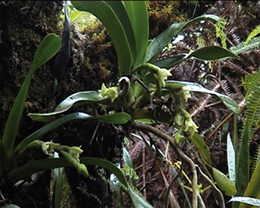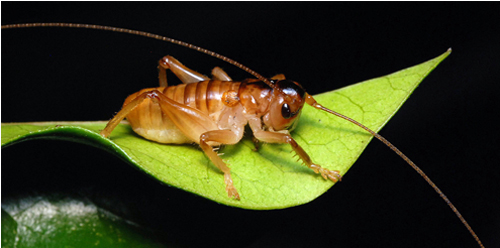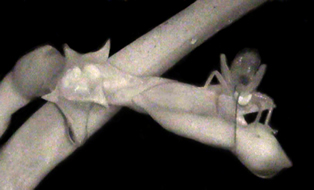Reunion: Rare orchid pollinated by cricket
18.01.10
Scientists on the remote island of Reunion in the Indian Ocean found something they did not expect: an orchid that’s pollinated by a cricket.
The Orchidaceae exhibit the widest range of pollinators in the plant kingdom, but these normally take the form of Hymenoptera (bees, wasps, and ants), Lepidoptera (moths and butterflies), and the Coleoptera (beetles). The discovery of a cricket, order Orthoptera, acting as a pollinator – instead of as the usual botanophage – was a complete surprise for the team from the University of Reunion led by Claire Michenau (who were working with RBG Kew and University of Strasbourg scientists).
 Angraecum cadetii, an epiphyte, is one of the rarest known orchids of a grouping of over 200 species. Interestingly, it has an illustrious cousin from Madagascar - which also has a curious pollinator.
Angraecum cadetii, an epiphyte, is one of the rarest known orchids of a grouping of over 200 species. Interestingly, it has an illustrious cousin from Madagascar - which also has a curious pollinator.
Angraecum cadetii
© Claire Michenau & Jacques Fournel
Angraecum sesquipedale provided Charles Darwin with one of his most intriguing riddles and, ultimately, ridiculed solutions. When studying this orchid he theorised that the nectar, held at the end of a 30 cm tube, must be reachable by an unknown animal with a similar length tongue. It wasn’t until 41 years later, in 1903, that a hawk moth (Xanthopan morgani praedicta) was to be found feeding on the plant (with its 35 cm proboscis) and, thus, proved Darwin right.

Crickets usually eat plants, not ensure their successful reproduction. So it was a complete shock to the scientists when this beastie crawled into view. © Sylvain Hugel
Hawk moths are less common on Reunion, and the nectar spur in A. cadetii was much shorter than in A. sesquipedale, so night vision cameras were used to catch the protagonist in the act. It was a complete surprise to the team to watch a wingless cricket fit its head perfectly into the nectar spur. The pollen stuck to the insects head ready to fertilise other nearby plants.

The orchid being pollinated by the cricket was caught on night vision cameras. These nocturnal foragers reached the flowers by climbing up leaves of the orchid or jumping across from neighbouring plants.
© Claire Michenau & Jacques Fournel
The cricket was the only pollinator observed on the plant and as a complete bonus was found to be new to science in the genus Glomeremus.
The full article can be found in Annals of Botany
Related links:
Nymphaea tetragona: A rare and endangered plant
05.01.10
 The Pygmy Water-lily, Nymphaea tetragona (Ait.) Georgi (Nymphaeaceae), is the Asia-tropical representative of the diminutive water-lilies.
The Pygmy Water-lily, Nymphaea tetragona (Ait.) Georgi (Nymphaeaceae), is the Asia-tropical representative of the diminutive water-lilies.